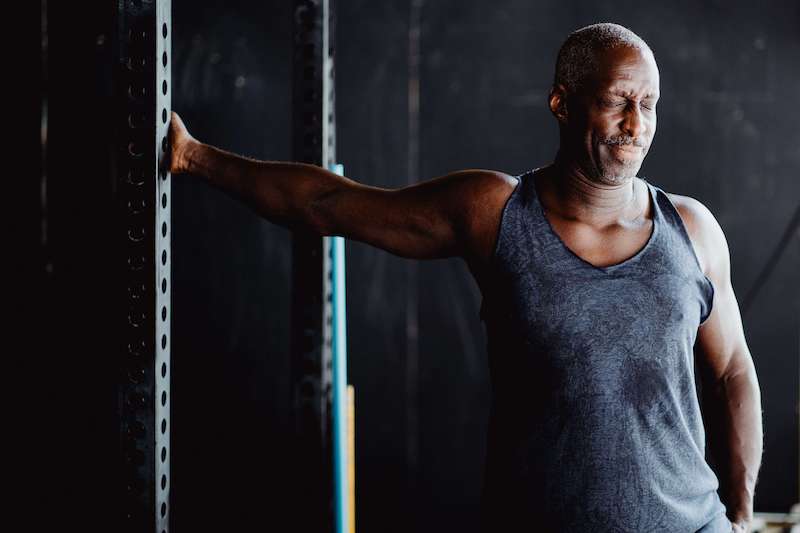
Shoulder Pain—Recommended Treatments and Prevention Methods
Shoulder pain treatment options vary widely and can be confusing without a medical degree to help interpret your options. Shoulder pain affects most everyone in their lifetime and can range from minor soreness to debilitating pain.
While extremely common, shoulder pain can be easily prevented with lifestyle modification as well as successfully treated with the proper rehabilitation. In the segment below, we’ll discuss shoulder anatomy and the most common causes, types, and treatments for shoulder pain.
What does the Anatomy of the Shoulder Joint Look Like?
The shoulder is a complex structure made up of bone, cartilage, muscles, tendons, ligaments and bursa. All of these structures serve an important role in allowing your shoulder to be simultaneously very flexible while maintaining stability. Few other joints in the body have such a large range of motion while maintaining the capacity to lift and carry hundreds of pounds at a time.
Shoulder Muscles and Tendons
The shallow bony socket of the shoulder allows for this greater flexibility while the muscles of the rotator cuff provide our much needed stability. The rotator cuff is a grouping of four muscles that attach to your humerus (arm bone) and hold it in place in the socket of your scapula (shoulder blade). The muscles of the rotator cuff (supraspinatus, infraspinatus, subscapularis, and teres minor) play a crucial role in allowing you to lift and rotate your arm with good mechanics. The biceps is another important muscle that provides stability and function to the shoulder. Tendons are the attachment points that connect your muscle onto the bone and are often vulnerable to injury.
Shoulder Labrum and Bursa
Anything that moves experiences friction, and the more movement available means the more wear and tear that occurs. Because our shoulders have such a large range of motion and are so frequently used throughout the day, our body has developed two defense mechanisms to protect our muscles and bones from this wear and tear: the labrum and the bursa. The shoulder labrum is a piece of tissue that sits between the arm bone and the socket of the shoulder and both deepens the socket for stability and acts as a cushion between bones. The bursa are fluid filled sacs that act as little pillows between areas that frequently experience friction.

Shoulder Ligaments and the Shoulder Capsule
Speaking of stability, we have many non contractile pieces of connective tissue that help hold the shoulder in the socket. These ligaments join together deep in the shoulder in a complex network of fibers to form the shoulder capsule. When a capsule becomes too lax, it can lead to shoulder dislocations and if it becomes too tight it can lead to loss of range of motion or even frozen shoulder.
Now that you have a basic understanding of the structures of the shoulder joint, let’s dive specifically into types and causes of injury to the shoulder. While this part may seem doom and gloom, don’t worry…there’s hope in the treatment section!
How is Shoulder Pain Diagnosed?

Diagnosis of a shoulder injury can be done accurately through collection of medical history and a physical examination by a physical therapist or physician.
Imaging is only necessary when a fracture is suspected, in preparation for surgery, or when you fail to respond to a normal course of conservative treatment such as physical therapy. A physical therapist will be able to determine and refer out when further imaging is indicated.
How can a Physical Therapist Help Me With Shoulder Pain?
Physical therapy, also known as “physiotherapy” or “rehabilitation,” is the first line of defense for shoulder injury. Getting physical therapy prior to imaging has been shown to result in better outcomes and drastically decreases the cost of care. The purpose of physical therapy is to not only help you heal faster from an injury, but also to improve your overall function and prevent recurrence.
Physical Therapy Evaluation: A physical therapy evaluation consists of a review of your medical history and imaging and a physical examination to measure your strength, range of motion, flexibility, shoulder mechanics, and other signs of injury.
Physical Therapy Diagnosis: Based on the findings from your physical therapy evaluation, your physical therapist will identify the nature and severity of the pain or injury.
Physical Therapy Treatment: Physical therapy treatment for shoulder pain consists of a combination of the following three interventions:

Manual Therapy: Manual therapy is the act of using hands-on techniques to help you recover faster by increasing joint mobility, decreasing pain, relaxing tight muscles, and engaging the right muscles to move their best. Commonly referred to as “body work,” manual therapy includes myofascial release, joint mobilization, joint manipulation and adjustment, tool assisted work, and many more modalities to help your tissues move better.

Movement Analysis: Movement is a symphony of all the systems in your body – it’s a result of how you breathe, how you lift, how you walk, and so much more. We evaluate your movement patterns and posture to make sure every last aspect of your movement system is working to aid healing and prevent future injury.

Corrective Exercise: Based on specific findings from your examination, we will prescribe corrective exercises that will help decrease pain, improve strength, and restore mobility.
Don’t forget in all 50 states you can see a physical therapist without a physician referral. The sooner your shoulder symptoms are diagnosed and treated, the higher the chances you have of making a full recovery.
Can Injections Help Shoulder Pain?
We’ve all heard the horror stories and success stories surrounding shoulder injections. But when is the right time to pursue an injection? While injections are often overused and do not make for a complete course of care for shoulder pain, they can have great outcomes when combined with physical therapy
Cortisone Injections for shoulder pain
There are pros and definite cons to cortisone injection and outcomes will vary based on your specific diagnosis. Cortisone is a hormone that is injected into the shoulder that helps reduce inflammation. After several weeks of physical therapy, your physical therapist may determine that inflammation in the joint is inhibiting your ability to fully rehabilitate.
With a cortisone injection addressing the inflammation, you may be able to make greater gains in your range of motion, pain, and strength. However, be cautious with jumping the gun on a cortisone injection. Research has demonstrated that repeated use of cortisone actually leads to muscle and tendon degradation rather than healing, meaning you want to limit your number of injections to only a few in a lifetime.
Additionally, some people have felt temporary systemic side effects on their mood and personality after the use of cortisone. Cortisone injections are covered by insurance when deemed appropriate by a physician. Ask your physical therapist if they believe a cortisone injection is appropriate and they can refer you to a trusted orthopedist for the procedure.
Regenerative Injections for shoulder pain
Regenerative injections such as Platelet Rich Plasma (PRP), O-zone therapy, prolozone, and stem cells are rapidly growing in popularity. Rather than ridding your body of inflammation without addressing the root cause of the inflammation, these injections actually cause an organic inflammatory response that results in expedited healing of the tissues.
While this may sound counterintuitive, the body of research in support of regenerative injection is increasing. The downside? These injections aren’t foolproof and are not covered by insurance. You do risk the chance of paying a lot out of pocket for an injection that isn’t effective for your specific ailment.
What are Other Alternative Treatments for Shoulder Pain?
Alternative Medicine or “Integrative Medicine” includes massage, Rolfing, acupuncture, supplementation, and many many more. Combined with physical therapy for diagnostics, strength training, and body mechanics instruction, these therapies can be highly effective at treating soft tissue and systemic inflammation in the body.
When Should Shoulder Surgery Be Considered?
Surgery is typically the last resort for shoulder pain. If you’ve attempted months of PT, regenerative injections, and alternative therapy and you still haven’t regained your baseline function, it may be time to discuss further imaging and possibly surgery. Be sure to work closely with a physical therapist who is monitoring your progress and can make the referral to a trusted orthopedic surgeon when needed.
Conclusion
There’s hope for safe and effective recovery from shoulder pain.

While shoulder pain or injury can be a painful and frustrating experience, there is hope for full recovery. MovementX guarantees the highest quality services with personalized care that goes above and beyond that found in a traditional clinic. We are a mobile physical therapy company providing care in your home, gym, office, or one of our local clinics.
Not only do our expert physical therapists accurately diagnose and treat your shoulder pain, we work hard to coordinate your care with all members of your care team. You have on-demand access to physical therapy in person or by phone, video, or email at all hours of the day. We truly believe that when you can move your best, you can live your best.
About the Author
Dr. Keaton Ray is a physical therapist in Portland, OR and Chief Operations Officer at MovementX. She is a Board Certified Specialist in Orthopedics, a spine specialist, and a certified strength and conditioning coach. Keaton Ray utilizes a combination of strength training and hands-on manual therapy to help her patients move their best so they can live their best. She loves helping people learn how to walk again, train for a marathon, and everything in between.








